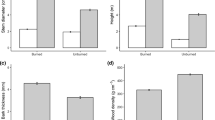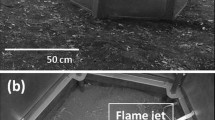Abstract
Fire is known to benefit morel production, but the details of how or why remain unknown. To investigate the effects of fire treatment on the occurrence and yield of the morel Morchella importuna in semi-artificial, field-based setups, we designed surface fire treatments using different quantities of burning material (dry Pinaceae twigs). Developmental stages of M. importuna, including the formation and degeneration of mycelium, formation of ascocarp primordia, ascocarp initials, and mature ascocarps, were evaluated in square-meter quadrats in field experiments. Morel yields and soil were compared. Fire treatments corresponding to 1.7 and 2.5 kg burning material/m2 resulted in clearly increased levels of soil minerals and nutrients, and significantly increased formation of ascocarp primordial and morel yields. None of the fire treatments had a significant effect on the germination rate of primordia. Fire treatments corresponding to 0.8 kg burning material/m2 did not increase morel yield. Surface fires increased the suitability of soils for the growth and productivity of ascocarps of M. importuna if sufficient burning material is used.



Similar content being viewed by others
References
Abraham J (2013) Organic carbon estimations in soils: analytical protocols and their implications. Rubber Sci 26:45–54
Buscot F (1989) Field observations on growth and development of Morchella rotunda and Mitrophora semilibera in relation to forest soil temperature. Can J Bot 67:589–593
Bremner JM, Mulvaney CS (1982) Methods of soil analysis. American Society of Agronomy, Wisconsin
Brzostowski A, Bielawski L, Orlikowska A, Plichta S, Falandysz J (2009) Instrumental analysis of metals profile in Poison Pax (Paxillus involutus) collected at two sites in Bory Tucholskie. Chem Anal (Warsaw) 54:1297–1308
Claridge AW, Trappe JM, Hansen K (2009) Do fungi have a role as soil stabilizers and remediators after forest fire? Forest Ecol Manag 257:1063–1069
Du XH, Zhao Q, O’Donnell K, Rooney AP, Yang ZL (2012) Multigene molecular phylogenetics reveals true morels (Morchella) are especially species-rich in China. Fungal Genet Biol 49:455–469
Du XH, Zhao Q, Yang ZL (2014) Diversity, evolutionary history and cultivation of morels: a review. Mycosystema 33:183–197 (in Chinese)
Du XH, Zhao Q, Xia EH, Gao LZ, Richard F, Yang ZL (2017) Mixed-reproductive strategies, competitive mating-type distribution and life cycle of fourteen black morel species. Sci Rep UK 7:1493
Fan ZH, Zheng LY (2013) A method for Morchella cultivation with wheat interplanting. Patent for Invention in China, ZL201310113092.X
Goldway M, Amir R, Goldberg D, Hadar Y, Levanon D (2000) Morchella conica exhibiting a long fruiting season. Mycol Res 104:1000–1004
Greene DF, Hesketh M, Pounden E (2010) Emergence of morel (Morchella) and pixie cup (Geopyxis carbonaria) ascocarps in response to the intensity of forest floor combustion during a wildfire. Mycologia 102:766–773
He PX, Liu W, Cai YL, He XS (2015) Strain identification and phylogenetic analysis of cultivated and wild strains of Morchella belonging to Elata Clade in China. J Zhengzhou Univ Light Indust (Nat Sci) 30:26–29 (in Chinese)
Kawagishi H, Hamajima K, Takanami R, Nakamura T, Sato Y, Akiyama Y, Sano M, Tanaka O (2004) Growth promotion of mycelia of the Matsutake mushroom Tricholoma matsutake by D-isoleucine. Biosci Biotechnol Biochem 11:2405–2407
Korb JE, Fulé PZ, Stoddard MT (2012) Forest restoration in a surface fire-dependent ecosystem: an example from a mixed conifer forest, southwestern Colorado, USA. Forest Ecol Manag 269:10–18
Kuo M, Dewsbury DR, O’Donnell K, Carter MC, Rehner SA, Moore JD, Moncalvo JM, Canfield SA, Stephenson SL, Methven AS, Volk TJ (2012) Taxonomic revision of true morels (Morchella) in Canada and the United States. Mycologia 104:1159–1177
Li QL, Ding C, Fan L (2013a) Trophic manner of morels analyzed by using stable carbon isotopes. Mycosystema 32:213–223 (in Chinese)
Li X, Chen Z, Peng C, Han Y, Xu J, Long Z (2013b) Effect of different ferric fertilizers on planting Morchella conica fruiting yields and analyses of the microflora and bioactivities of its grown soil. Afr J Microbiol Res 7:4707–4716
Liu H, Xu J, Li X, Zhang Y, Yin A, Wang J, Long Z (2015) Effects of microelemental fertilizers on yields, mineral element levels and nutritional compositions of the artificially cultivated Morchella conica. Sci Hortic Amsterdam 189:86–93
Liu QZ, Ma HS, Zhang Y, Dong CH (2017a) Artificial cultivation of true morels: current state, issues and perspectives. Crit Rev Biotechnol 1:1–13
Liu QY, Liu HM, Chen CQ, Wang JM, Han Y, Long ZF (2017b) Effects of element complexes containing Fe, Zn and Mn on artificial morel’s biological characteristics and soil bacterial community structures. PLoS One 12:e0174618
Loizides M, Bellanger JM, Clowez P, Richard F, Moreau PA (2016) Combined phylogenetic and morphological studies of true morels (Pezizales, Ascomycota) in Cyprus reveal significant diversity, including Morchella arbutiphila and M. disparilis spp. Mycol Prog 15:39
Martin AM (1982) Submerged growth of Morchella esculenta in peat hydrolysates. Biotechnol Lett 4:13–18
Masaphy S (2010) Biotechnology of morel mushrooms: successful fruiting body formation and development in a soilless system. Biotechnol Lett 32:1523–1527
Masaphy S, Zabari L (2013) Observations on post-fire black morel ascocarp development in an Israeli burnt forest site and their preferred micro-sites. Fungal Ecol 6:316–318
Masaphy S, Zabari L, Gander-Shagug G (2008) Morchella conica Pers. proliferation in post-fire forests in northern Israel. Israel J Plant Sci 56:315–319
Mehlich A (1982) Comprehensive methods in soil testing. Mimeo-89, North Carolina Department of Agriculture, Raleigh, NC
O’Donnell K, Rooney AP, Mills GL, Kuo M, Weber NS, Rehner SA (2011) Phylogeny and historical biogeography of true morels (Morchella) reveals an early Cretaceous origin and high continental endemism and provincialism in the Holarctic. Fungal Genet Biol 48:252–265
Ower R (1982) Notes on the development of the morel ascocarp: Morchella esculenta. Mycologia 74:142–144
Ower RD, Mills GL, Malachowski JA (1986) Cultivation of Morchella. US patent no. 4594809
Pilz D, Weber NS, Carter MC, Parks CG, Molina R (2004) Productivity and diversity of morel mushrooms in healthy, burned, and insect-damaged forests of northeastern Oregon. Forest Ecol Manag 198:367–386
Taşkın H, Büyükalaca S, Doğan HH, Rehner SA, O’Donnell K (2010) A multigene molecular phylogenetic assessment of true morels (Morchella) in Turkey. Fungal Genet Biol 47:672–682
Tessier JT, Raynal DJ (2003) Vernal nitrogen and phosphorus retention by forest understory vegetation and soil microbes. Plant Soil 256:443–453
Traeger S, Altegoer F, Freitag M, Gabaldon T, Kempken F, Kumar A, Marcet-Houben M, Pöggeler S, Stajich JE, Nowrousian M (2013) The genome and development-dependent transcriptomes of Pyronema confluens: a window into fungal evolution. PLoS genet 9:e1003820
Volk TJ, Leonard TJ (1990) Cytology of the life-cycle of Morchella. Mycol Res 94:399–406
Winder RS (2006) Cultural studies of Morchella elata. Mycol Res 110:612–623
Winder RS, Keefer ME (2008) Ecology of the 2004 morel harvest in the Rocky Mountain Forest District of British Columbia. Botany 86:1152–1167
Wurtz TL, Wiita AL, Weber NS, Pilz D (2005) Harvesting morels after wildfire in Alaska. United StatesDepartment ofAgriculture (USDA), Research Note PNW-RN-546
Xiong C, Li Q, Chen C, Chen Z, Huang W (2016) Neuroprotective effect of crude polysaccharide isolated from the fruiting bodies of Morchella importuna against H2O2-induced PC12 cell cytotoxicity by reducing oxidative stress. Biomed Pharmacother 83:569–576
Acknowledgements
This article is dedicated to commemorating Prof. Linyong Zheng of the Sichuan Academy of Agricultural Sciences (SAAS) for his great contributions to the development of the edible mushroom industry in Sichuan Province, China. This work was supported by the projects of the Science and Technology Department of Sichuan Province, China (2016NYZ0040, 2016GZ0355) and the Sichuan Mushroom Innovation Team.
Author information
Authors and Affiliations
Corresponding author
Additional information
Section Editor: Hans-Josef Schroers
Rights and permissions
About this article
Cite this article
Li, Q., Xiong, C., Huang, W. et al. Controlled surface fire for improving yields of Morchella importuna . Mycol Progress 16, 1057–1063 (2017). https://doi.org/10.1007/s11557-017-1350-9
Received:
Revised:
Accepted:
Published:
Issue Date:
DOI: https://doi.org/10.1007/s11557-017-1350-9




